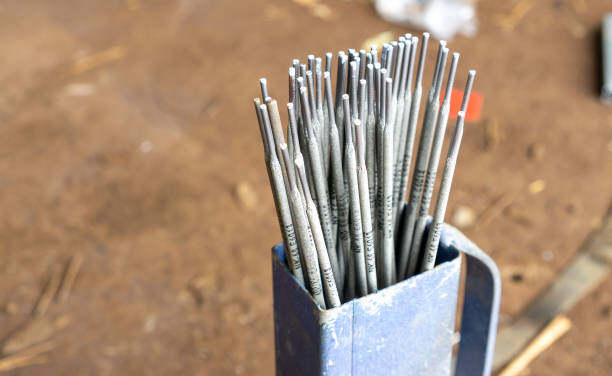Tungsten electrode, a fundamental component in welding, plays a pivotal role in achieving high-quality welds across various materials and welding processes. This article delineates the types, selection criteria, maintenance, and application of tungsten electrodes in the welding industry.

I. Types of Tungsten Electrodes
A. Pure Tungsten
Pure tungsten electrodes, renowned for their high melting point and thermal conductivity, find utility in AC welding applications and are ideal for welding aluminum and magnesium alloys.
1) Advantages:
2) Disadvantages:
B. Thoriated Tungsten
Thoriated tungsten electrodes, infused with thorium oxide, exhibit excellent arc stability and longevity, making them well-suited for DC welding processes and applications requiring high current density.
1) Advantages:
Superior arc stability
Long electrode life
2) Disadvantages:
C. Ceriated Tungsten
Ceriated tungsten electrodes, doped with cerium oxide, offer superior arc starting characteristics and enhanced weld pool control, making them a preferred choice for both AC and DC welding operations.
1) Advantages:
2) Disadvantages:
D. Lanthanated Tungsten
Lanthanated tungsten electrodes, containing lanthanum oxide, deliver exceptional arc stability, reduced spatter, and extended electrode life, catering to a wide range of welding applications.
1) Advantages:
2) Disadvantages:
E. Zirconiated Tungsten
Zirconiated tungsten electrodes, incorporating zirconium oxide, excel in high-temperature applications and provide excellent arc stability, making them suitable for AC welding of aluminum and magnesium alloys.
1) Advantages:
2) Disadvantages:
II. Selection Criteria for Tungsten Electrodes
1) Material Compatibility
Select tungsten electrodes compatible with the base metal being welded, considering factors such as conductivity, melting point, and chemical reactivity for optimal welding performance.
2) Welding Process
Tailor electrode selection to the specific welding process employed, whether it be TIG (GTAW), Stick (SMAW), or Plasma (PAW), to ensure compatibility with the welding equipment and process requirements.
3) Amperage Range
Choose tungsten electrodes with appropriate diameter and composition to accommodate the desired welding amperage range, ensuring consistent arc stability and penetration depth.
4) Polarity
Optimize electrode selection based on welding polarity, whether AC, DCEN (Direct Current Electrode Negative), or DCEP (Direct Current Electrode Positive), to maximize arc performance and weld quality.
5) Welding Position
Consider the welding position—whether flat, horizontal, vertical, or overhead—in electrode selection to ensure optimal arc stability, weld penetration, and deposition rate across different welding scenarios.
III. Preparation and Grinding of Tungsten Electrodes
1) Correct Grinding Angle
Grind tungsten electrodes to a precise taper angle—typically 15 to 20 degrees—to facilitate smooth arc initiation, consistent arc stability, and precise control of weld pool formation.
2) Grinding Equipment
Utilize dedicated tungsten electrode grinding equipment, such as bench grinders, tungsten grinders, or portable grinding wheels, equipped with diamond or aluminum oxide grinding wheels for optimal results.
3) Electrode Contamination Prevention
Exercise caution to prevent electrode contamination during grinding, handling, and storage, as contaminants such as oil, grease, or foreign particles can adversely affect arc stability and weld quality.
IV. Tungsten Electrode Maintenance
1) Storage Practices
Store tungsten electrodes in dry, clean containers or electrode storage tubes to prevent moisture absorption, oxidation, or contamination, ensuring optimal electrode performance and longevity.
2) Inspection
Regularly inspect tungsten electrodes for signs of damage, wear, or contamination, such as cracks, chipping, or discoloration, and discard or redress electrodes as necessary to maintain welding quality.
3) Redressing Electrodes
Redress tungsten electrodes using appropriate electrode dressing tools, such as dedicated electrode grinders or abrasive stones, to restore the electrode tip geometry and remove surface contaminants.
V. Common Tungsten Electrode Welding Applications
1) Steel Welding
Tungsten electrodes find extensive use in steel welding applications, including structural steel fabrication, pipe welding, and automotive manufacturing, owing to their versatility and compatibility with various welding processes.
2) Stainless Steel Welding
In stainless steel welding, tungsten electrodes excel in providing precise arc control, clean weld appearance, and minimal heat-affected zone, ensuring high-quality welds with excellent corrosion resistance and mechanical properties.
3) Aluminum Welding
Tungsten electrodes are indispensable in aluminum welding applications, offering superior arc stability, oxide removal, and weld penetration, facilitating pristine welds on aluminum alloys in diverse industries such as aerospace, automotive, and marine fabrication.
4) Titanium Welding
In titanium welding, tungsten electrodes play a crucial role in achieving precise arc control, minimal contamination, and exceptional weld quality, ensuring the integrity and performance of titanium components in aerospace, medical, and chemical processing applications.
VI. Future Trends in Tungsten Electrode Technology
1) Advancements in Composition
Continued research and development efforts are expected to yield innovative tungsten electrode compositions tailored for specific welding applications, offering enhanced performance, longevity, and environmental sustainability.
2) Development of Hybrid Electrodes
The emergence of hybrid tungsten electrode designs, incorporating novel materials or coatings, holds promise for optimizing arc characteristics, weld pool behavior, and electrode longevity across diverse welding processes and materials.
3) Integration with Welding Automation
The integration of tungsten electrode technology with advanced welding automation systems, including robotic welding cells and intelligent welding platforms, is poised to revolutionize welding processes, productivity, and quality control in manufacturing and fabrication industries.
VII. Conclusion
In conclusion, tungsten electrodes stand as indispensable pillars of welding technology, offering unparalleled performance, versatility, and precision across diverse welding applications and materials. By understanding the nuances of tungsten electrode selection, preparation, and application, welders can unlock the full potential of this essential welding consumable, ensuring optimal weld quality, productivity, and safety in their welding endeavors.
Related articles
1. How To Shape Tungsten Electrode For TIG Welding?
2. About Tungsten in TIG Welding: Types, Selection and Use
3. How to Identify and Solve Tungsten Electrode and Arc Issues
4. A Guide to Arc Welding Electrodes
5. Guide to Optimal TIG Welding Setup




